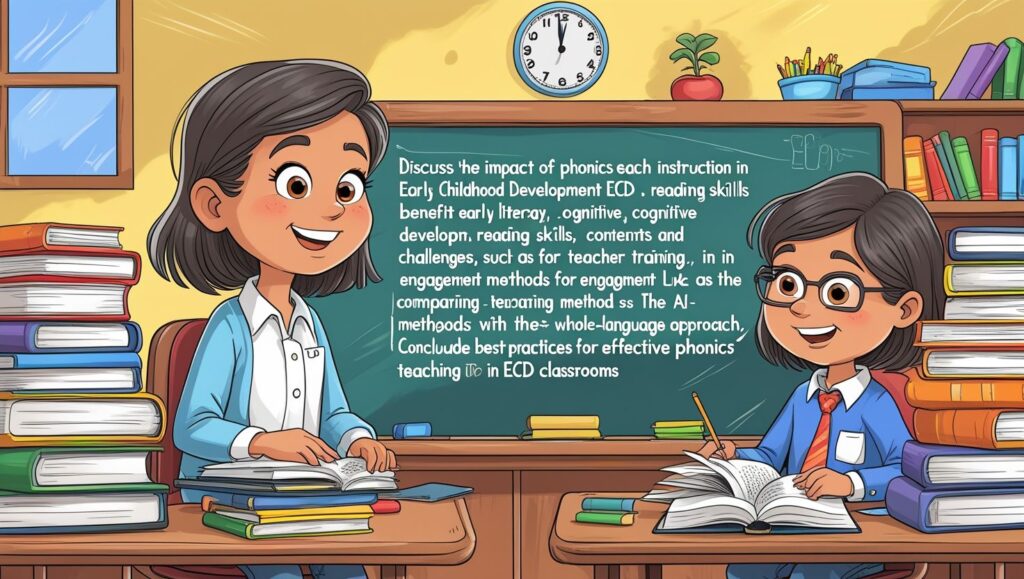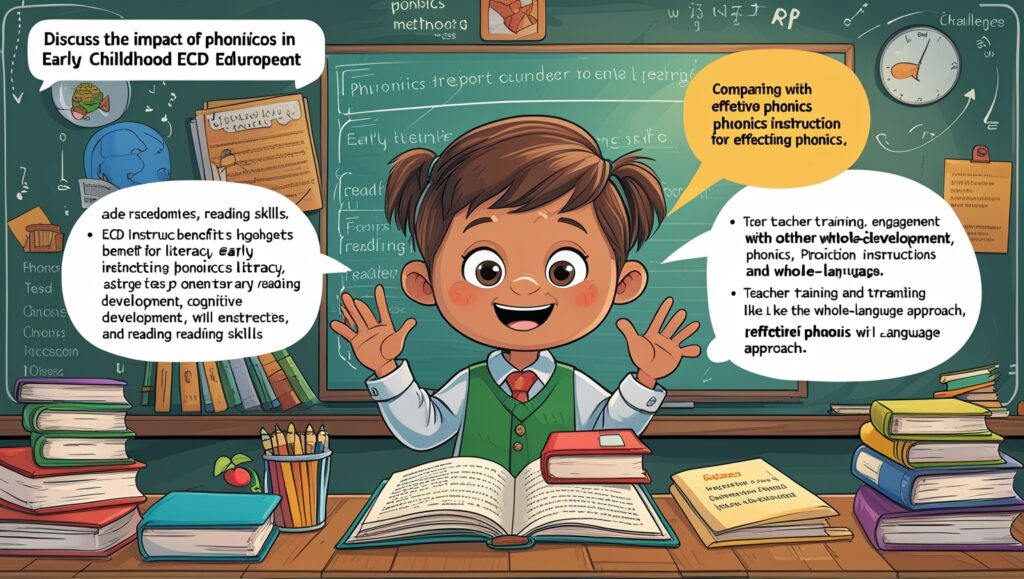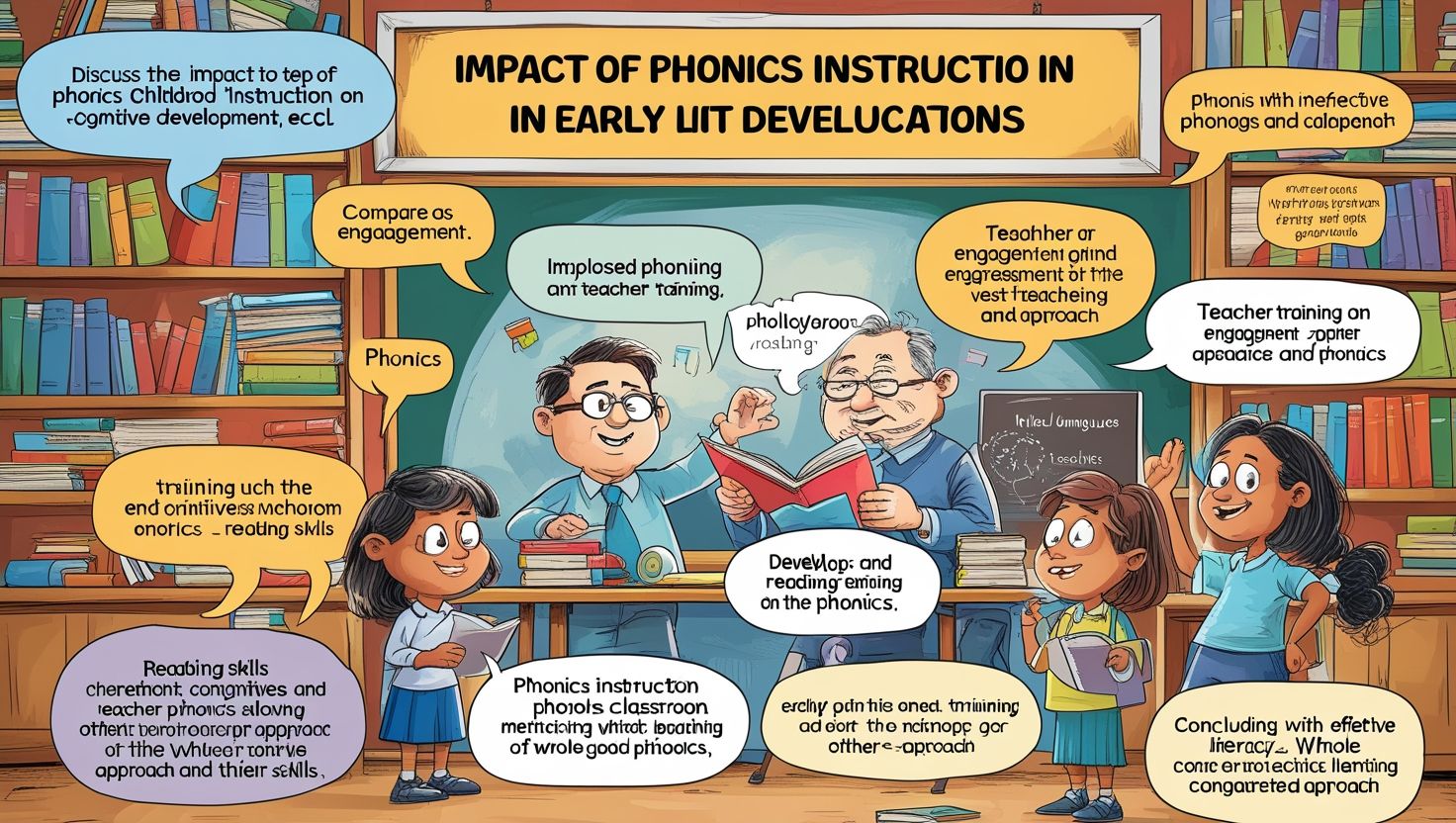Introduction
The Impact of Phonics in Early Childhood Development (ECD) Education, Early Childhood Development (ECD) is a crucial phase in a child’s learning journey, laying the foundation for lifelong literacy and cognitive skills. Among the various instructional methods used to teach reading and writing, phonics has emerged as one of the most effective strategies. Phonics, which involves teaching children the relationship between letters (graphemes) and their corresponding sounds (phonemes), plays a pivotal role in developing early literacy skills.
This article explores the impact of phonics in ECD education, discussing its benefits, challenges, and effectiveness compared to other literacy approaches. Additionally, it examines how phonics supports cognitive development, language acquisition, and reading fluency in young learners.
Understanding Phonics in Early Childhood Education
What is Phonics?
Phonics is a method of teaching reading and writing by developing learners’ ability to hear, identify, and manipulate phonemes—the smallest units of sound in a language. It emphasizes the systematic relationship between written letters and spoken sounds, enabling children to decode words independently.
There are different approaches to phonics instruction, including:
- Synthetic Phonics – Children learn to convert letters into sounds and blend them to form words (e.g., /c/ /a/ /t/ → “cat”).
- Analytic Phonics – Learners analyze whole words to identify phonetic patterns (e.g., recognizing “cat,” “bat,” and “hat” share the “-at” sound).
- Embedded Phonics – Phonics is taught within the context of reading rather than as a separate lesson.
The Role of Phonics in ECD
Early childhood (ages 3-8) is a critical period for language and literacy development. Phonics instruction during this stage helps children:
- Develop phonemic awareness (recognizing and manipulating sounds in words).
- Improve decoding skills (sounding out unfamiliar words).
- Enhance spelling and writing abilities.
- Build reading fluency and comprehension.

The Impact of Phonics on Early Literacy Development
1. Improves Reading Skills
Research consistently shows that phonics-based instruction significantly enhances reading proficiency in young children. A landmark study by the National Reading Panel (2000) found that systematic phonics teaching leads to better word recognition, spelling, and reading comprehension compared to non-phonics approaches.
- Decoding Ability: Phonics helps children break down words into sounds, making it easier to read unfamiliar words independently.
- Fluency: As children master phonetic patterns, they read more smoothly and with greater confidence.
2. Enhances Spelling and Writing
Since phonics teaches the sound-letter relationship, children can apply this knowledge to spell words correctly. Instead of relying on memorization, they use phonetic rules to construct words, leading to:
- Fewer spelling errors.
- Better sentence formation.
- Increased confidence in writing tasks.
3. Supports English Language Learners (ELLs)
For children learning English as a second language, phonics provides a structured way to grasp pronunciation and word formation. Studies indicate that ELLs taught with phonics show faster progress in reading and speaking than those taught through whole-language methods.
4. Builds Cognitive and Linguistic Skills
Phonics instruction strengthens cognitive abilities such as:
- Auditory Discrimination: Differentiating between similar sounds (e.g., /b/ vs. /p/).
- Memory Retention: Remembering sound patterns and applying them in new contexts.
- Problem-Solving: Decoding unfamiliar words using phonetic rules.
5. Reduces Reading Difficulties and Dyslexia Risk
Early phonics intervention can help identify and support children at risk of dyslexia and other reading difficulties. Structured phonics programs improve phonological processing, which is often a challenge for dyslexic learners.
Challenges of Phonics Instruction in ECD
Despite its benefits, phonics instruction faces some challenges:
1. Overemphasis on Decoding at the Expense of Comprehension
Some critics argue that excessive focus on sounding out words may neglect reading comprehension. A balanced approach that combines phonics with whole-language strategies (e.g., storytelling, vocabulary building) is often recommended.
2. Teacher Training and Resources
Effective phonics instruction requires well-trained teachers and appropriate materials. In under-resourced schools, educators may lack the tools to implement phonics effectively.
3. Variability in Language Systems
English is a complex language with many irregular spellings (e.g., “through,” “knight”). While phonics provides general rules, exceptions can confuse young learners.
4. Engagement and Motivation
Some children may find repetitive phonics drills boring. Incorporating games, songs, and interactive activities can make phonics more engaging.

Phonics vs. Whole Language Approach
The whole language approach emphasizes learning to read through exposure to literature and context clues rather than explicit sound-letter instruction. While it fosters a love for reading, research suggests that it is less effective for early decoding skills compared to phonics.
Why Phonics is More Effective in ECD
- Provides a structured, step-by-step method for reading.
- Empowers children to read independently without relying on memorization.
- Supported by scientific evidence as the most effective early literacy strategy.
However, a balanced literacy approach—combining phonics with whole-language techniques—can offer the best outcomes.
Best Practices for Teaching Phonics in ECD
To maximize the benefits of phonics, educators should:
- Start Early: Introduce phonics as soon as children begin recognizing letters (ages 3-4).
- Use Multisensory Techniques: Incorporate visual, auditory, and kinesthetic activities (e.g., sandpaper letters, sound games).
- Make it Fun: Use rhymes, songs, and digital phonics apps to maintain engagement.
- Provide Ample Practice: Encourage reading decodable books that reinforce phonetic patterns.
- Assess Progress: Regularly monitor students’ decoding and comprehension skills.
Conclusion
The Impact of Phonics in Early Childhood Development (ECD) Education, Phonics has a profound impact on early childhood education by equipping young learners with essential reading and writing skills. Its systematic approach enhances decoding, spelling, and cognitive development while reducing the risk of reading difficulties. However, for optimal results, phonics should be integrated with other literacy strategies in a balanced and engaging manner.
As education systems worldwide continue to refine early literacy instruction, phonics remains a cornerstone of effective ECD teaching. By investing in teacher training, resources, and research-backed methodologies, educators can ensure that every child develops strong foundational literacy skills for lifelong success.
References
- National Reading Panel (2000). Teaching Children to Read.
- Rose, J. (2006). Independent Review of the Teaching of Early Reading.
- Ehri, L. C. (2005). Learning to Read Words: Theory, Findings, and Issues.

sratxo
Loving the info on this website , you have done outstanding job on the content.
you’re really a excellent webmaster. The web site loading velocity is amazing. It sort of feels that you are doing any distinctive trick. Also, The contents are masterpiece. you’ve done a excellent job on this subject!
A person essentially help to make seriously articles I would state. This is the first time I frequented your website page and thus far? I amazed with the research you made to make this particular publish amazing. Magnificent job!
Great write-up, I am normal visitor of one¦s web site, maintain up the nice operate, and It is going to be a regular visitor for a lengthy time.
I?¦ll immediately snatch your rss as I can not to find your email subscription link or e-newsletter service. Do you have any? Please let me recognize in order that I may subscribe. Thanks.
Hello! I just would like to give a huge thumbs up for the great info you have here on this post. I will be coming back to your blog for more soon.
I must express some appreciation to you just for rescuing me from this particular matter. Just after exploring through the online world and coming across proposals that were not beneficial, I was thinking my entire life was gone. Existing without the approaches to the problems you have fixed all through your website is a serious case, as well as ones that might have adversely affected my entire career if I had not discovered your website. Your primary ability and kindness in controlling a lot of things was valuable. I’m not sure what I would’ve done if I had not encountered such a solution like this. I am able to now look ahead to my future. Thanks for your time so much for this skilled and effective guide. I will not think twice to recommend your blog post to any individual who desires guidance on this matter.
Spot on with this write-up, I truly assume this website wants much more consideration. I’ll in all probability be once more to learn much more, thanks for that info.
I gotta bookmark this web site it seems extremely helpful invaluable
You actually make it appear really easy with your presentation but I find this matter to be actually something which I think I might never understand. It kind of feels too complex and extremely broad for me. I’m having a look ahead for your subsequent submit, I’ll attempt to get the grasp of it!
As a Newbie, I am continuously browsing online for articles that can aid me. Thank you
With havin so much content and articles do you ever run into any issues of plagorism or copyright violation? My blog has a lot of exclusive content I’ve either written myself or outsourced but it looks like a lot of it is popping it up all over the web without my authorization. Do you know any solutions to help stop content from being ripped off? I’d really appreciate it.
I always was concerned in this topic and still am, appreciate it for posting.
I’m not sure exactly why but this site is loading very slow for me. Is anyone else having this problem or is it a issue on my end? I’ll check back later on and see if the problem still exists.
Wonderful blog! I found it while searching on Yahoo News. Do you have any suggestions on how to get listed in Yahoo News? I’ve been trying for a while but I never seem to get there! Cheers
Hey there this is somewhat of off topic but I was wanting to know if blogs use WYSIWYG editors or if you have to manually code with HTML. I’m starting a blog soon but have no coding knowledge so I wanted to get advice from someone with experience. Any help would be enormously appreciated!
Do you mind if I quote a couple of your articles as long as I provide credit and sources back to your blog? My website is in the exact same niche as yours and my users would genuinely benefit from some of the information you present here. Please let me know if this ok with you. Thanks!
I like the efforts you have put in this, thank you for all the great blog posts.